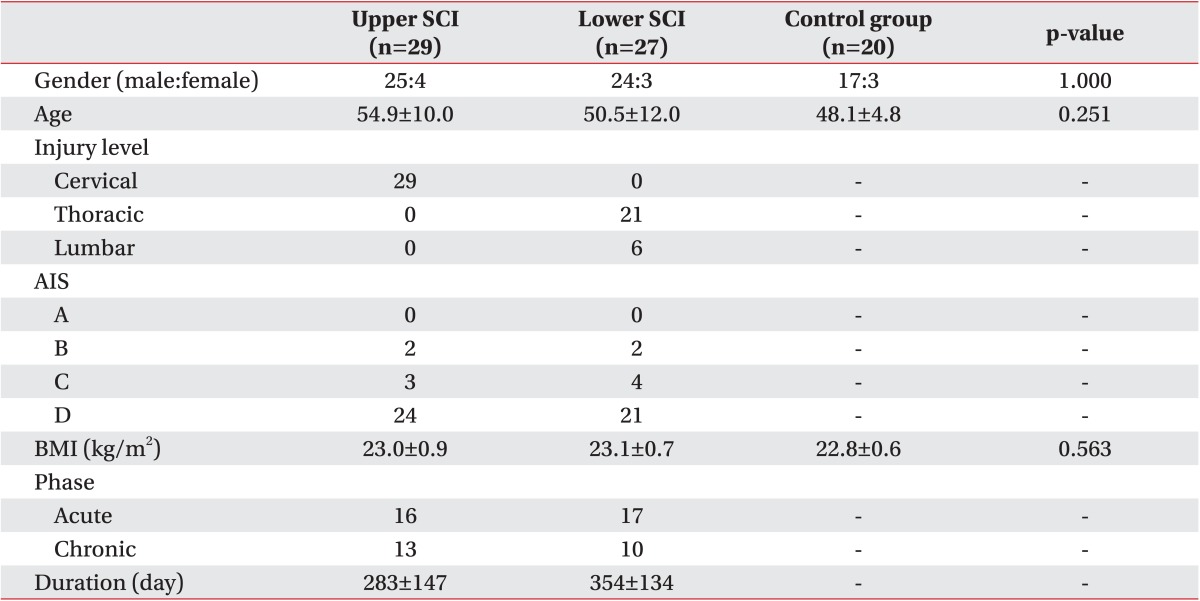1. Krassioukov AV, Karlsson AK, Wecht JM, Wuermser LA, Mathias CJ, Marino RJ, et al. Assessment of autonomic dysfunction following spinal cord injury: rationale for additions to International Standards for Neurological Assessment. J Rehabil Res Dev. 2007; 44:103–112. PMID:
17551864.

2. Uematsu S, Edwin DH, Jankel WR, Kozikowski J, Trattner M. Quantification of thermal asymmetry. Part 1: Normal values and reproducibility. J Neurosurg. 1988; 69:552–555. PMID:
3418388.
3. Edeiken J, Shaber G. Thermography: a reevaluation. Skeletal Radiol. 1986; 15:545–548. PMID:
3775420.

4. Downey JA, Miller JM, Darling RC. Thermoregulatory responses to deep and superficial cooling in spinal man. J Appl Physiol. 1969; 27:209–212. PMID:
5256205.

5. Feldman F. Thermography of the hand and wrist: practical applications. Hand Clin. 1991; 7:99–112. PMID:
1645364.

6. Feldman F, Nickoloff EL. Normal thermographic standards for the cervical spine and upper extremities. Skeletal Radiol. 1984; 12:235–249. PMID:
6505731.

7. Khan S, Plummer M, Martinez-Arizala A, Banovac K. Hypothermia in patients with chronic spinal cord injury. J Spinal Cord Med. 2007; 30:27–30. PMID:
17385266.

8. Roehl K, Becker S, Fuhrmeister C, Teuscher N, Futing M, Heilmann A. New, non-invasive thermographic examination of body surface temperature on tetraplegic and paraplegic patients, as a supplement to existing diagnostic measures. Spinal Cord. 2009; 47:492–495. PMID:
18957961.

9. Sherman RA, Ernst JL, Markowski J. Relationships between near surface blood flow and altered sensations among spinal cord injured veterans. Am J Phys Med. 1986; 65:281–297. PMID:
3789129.

10. Price MJ, Campbell IG. Effects of spinal cord lesion level upon thermoregulation during exercise in the heat. Med Sci Sports Exerc. 2003; 35:1100–1107. PMID:
12840629.

11. Park CI, Park ES, Kim YC, Lim KB, Yi CH. Digital infrared thermal imaging on patients with complete spinal cord injuries and central pain. J Korean Acad Rehabil Med. 1996; 20:436–441.
12. Claus-Walker J, Halstead LS, Carter RE, Campos RJ, Spencer WA, Canzoneri J 3rd. Physiological responses to cold stress in healthy subjects and in subjects with cervical cord injuries. Arch Phys Med Rehabil. 1974; 55:485–490. PMID:
4441259.
13. Bryce TN, Ragnarsson KT, Stein AB, Biering-Sorensen F. Spinal cord injury. In : Braddom RL, editor. Physical medicine and rehabilitation. 4th ed. Philadelphia: Saunders;2011. p. 1293–1345.
14. American Medical Association. Council on Scientific Affairs. Thermography in neurological and musculoskeletal conditions. Thermology. 1987; 2:600–607.
15. Boulant JA. Thermoregulation. In : Mackowiak PA, editor. Fever: basic mechanisms and management. 2nd ed. Philadelphia: Lippincott Williams & Wilkins;1997. p. 35–58.
16. Jurkovich GJ, Greiser WB, Luterman A, Curreri PW. Hypothermia in trauma victims: an ominous predictor of survival. J Trauma. 1987; 27:1019–1024. PMID:
3656464.
17. Luna GK, Maier RV, Pavlin EG, Anardi D, Copass MK, Oreskovich MR. Incidence and effect of hypothermia in seriously injured patients. J Trauma. 1987; 27:1014–1018. PMID:
3656463.

18. Tsuei BJ, Kearney PA. Hypothermia in the trauma patient. Injury. 2004; 35:7–15. PMID:
14728949.

19. Cosgriff N, Moore EE, Sauaia A, Kenny-Moynihan M, Burch JM, Galloway B. Predicting life-threatening coagulopathy in the massively transfused trauma patient: hypothermia and acidoses revisited. J Trauma. 1997; 42:857–862. PMID:
9191667.
20. Greene PS, Cameron DE, Mohlala ML, Dinatale JM, Gardner TJ. Systolic and diastolic left ventricular dysfunction due to mild hypothermia. Circulation. 1989; 80(5 Pt 2):III44–III48. PMID:
2805306.
21. Wright V, Johns RJ. Quantitative and qualitative analysis of joint stiffness in normal subjects and in patients with connective tissue diseases. Ann Rheum Dis. 1961; 20:36–46. PMID:
13786829.

22. Cesario TC, Darouiche RO. Thermoregulation in the SCI patient. In : Lin VW, editor. Spinal cord medicine: principles and practice. New York: Demos Medical Publishing;2003. p. 209–211.
23. Ring F. Thermal imaging today and its relevance to diabetes. J Diabetes Sci Technol. 2010; 4:857–862. PMID:
20663449.

24. Krauchi K, Wirz-Justice A. Circadian rhythm of heat production, heart rate, and skin and core temperature under unmasking conditions in men. Am J Physiol. 1994; 267(3 Pt 2):R819–R829. PMID:
8092328.

25. Matsukawa T, Ozaki M, Nishiyama T, Imamura M, Kumazawa T. Comparison of infrared thermometer with thermocouple for monitoring skin temperature. Crit Care Med. 2000; 28:532–536. PMID:
10708196.

26. Hershler C, Conine TA, Nunn A, Hannay M. Assessment of an infra-red non-contact sensor for routine skin temperature monitoring: a preliminary study. J Med Eng Technol. 1992; 16:117–122. PMID:
1404313.

27. Buono MJ, Jechort A, Marques R, Smith C, Welch J. Comparison of infrared versus contact thermometry for measuring skin temperature during exercise in the heat. Physiol Meas. 2007; 28:855–859. PMID:
17664677.

28. Chun SI, Park ES, Yi CH. Digital infrared thermal imaging on normal healthy subjects. J Korean Acad Rehabil Med. 1995; 19:425–430.
29. Tominaga S. Periodical, neurological-functional assessment for cervical cord injury. Paraplegia. 1989; 27:227–236. PMID:
2762011.

30. Folman Y, el Masri W. Spinal cord injury: prognostic indicators. Injury. 1989; 20:92–93. PMID:
2592085.

31. Besson M, Brook P, Chizh BA, Pickering AE. Tactile allodynia in patients with postherpetic neuralgia: lack of change in skin blood flow upon dynamic stimulation. Pain. 2005; 117:154–161. PMID:
16098664.

32. So YT, Olney RK, Aminoff MJ. A comparison of thermography and electromyography in the diagnosis of cervical radiculopathy. Muscle Nerve. 1990; 13:1032–1036. PMID:
2172814.

33. So YT, Aminoff MJ, Olney RK. The role of thermography in the evaluation of lumbosacral radiculopathy. Neurology. 1989; 39:1154–1158. PMID:
2549451.

34. Tchou S, Costich JF, Burgess RC, Wexler CE. Thermographic observations in unilateral carpal tunnel syndrome: report of 61 cases. J Hand Surg Am. 1992; 17:631–637. PMID:
1629541.

35. Jang YY, Byun SH, Lee SJ, Kim TU, Hyun JK. Clinical significance of digital infrared thermal imaging in unilateral ulnar neuropathy. J Korean Assoc EMG Electrodiagn Med. 2009; 11:78–84.
36. Balazy TE. Clinical management of chronic pain in spinal cord injury. Clin J Pain. 1992; 8:102–110. PMID:
1633373.








 PDF
PDF ePub
ePub Citation
Citation Print
Print



 XML Download
XML Download